What is the traditional flower of Easter? Definitely Lilies, I know that. But don’t you think Lilacs also add colors to our Easter holidays? Sure, they do. During that time, the garden seems to have its own Lilac festival.
However, as vivid, the color is, as firm the care should be. The good news is Lilacs don’t require much food, but they need the right one at the right time.
And that’s why I am here. If you are desired to get the best fertilizer for your Lilacs, I want you to go through my reviews once. I think that would be enough.
So, without further ado, let’s check out the result of my deep research.
Top 7 Fertilizer For Lilacs- Comparisons
| Fertilizer | NPK | Form | Type | Price |
|---|---|---|---|---|
| Miracle-Gro Shake ‘N Feed Flowering Plant Food | 18-6-12 | Granular | Semi-Organic | |
| Dr. Earth Flower Girl Natural Fertilizer | 3-9-4 | Granular | Organic | |
| Espoma Plant-tone Plant Food | 5-3-3 | Granular | Organic | |
| Nelson Plant Food For All Flowering Vines | 17-7-10 | Granular | Synthetic | |
| Osmocote Smart- Release Plant Food | 14-14-14 | Granular | Synthetic | |
| Scotts Evergreen Flowering Tree & Shrub Plant food | 11-7-7 | Granular | Synthetic | |
| Jobe’s Hanging Baskets & Potted Plants Fertilizer | 8-9-12 | Spike | Synthetic |
Top 7 Fertilizer For Lilacs- Review
1. Miracle-Gro Shake ‘N Feed Flowering Trees & Shrubs Continuous Release Plant Food

I guess you are not surprised to see the first piece. When you are going for plant foods, subconsciously, Miracle-Gro pops up in your head. And among their plenty of efficient fertilizers, I offer you the finest one that fits your Lilacs.
Nutrient Composition
What fertilizer to choose, Organic or Synthetic? I say leave it. Shake N Feed fertilizer shaves off this so-called picking dilemma because it delivers nutrients from both sources.
The fertilizer is a blend of polymer-coated urea, urea, ammonium phosphate, ammonium sulfate, feather meal, kelp meal, alfalfa meal, earthworm castings, bone meal, potassium sulfate, calcium carbonate, iron sucrate & manganese sucrate. And this rare blend of organic & synthetic sources makes it a semi-organic fertilizer.
However, the product label says it contains 7 essential macro & micronutrients including N (18%), P (6%), K (12%), Ca (3.3%), S (6.9%), Fe (2%) & Mn (1%). But my study says the sources also supply Mg, Cu, Fe, and Zn.
Nutrient Analysis
While you look at the NPK ratio, 18-6-12, the first thing that comes into your mind is, it has a high N ratio that is not preferable for Lilacs. But here is the twist-
11% of the N is the slow-releasing type that serves your Lilacs continuously for up to 3 months & 7% is available to feed your plants instantly. Probably that is why many growers marked this product as the best slow-release fertilizer for Lilacs.
Besides, the overall composition ensures deep green leaves with bright blooms.
Exclusive Highlights
Along with Lilacs, this Miracle-Gro product will cover all the flowering trees & shrubs of your garden. But the best bit is this fertilizer contains natural elements to feed the soil microbes.
You know, the soil microbes turn organic matter into nutrients to promote root strength and development. And thereby, the fertilizer serves both above & below the soil.
Applying Method
For your inground Lilacs, first of all, figure out the dripline & measure the diameter. Then for a 2 ft of diameter, shake 2 & half tablespoons of fertilizer uniformly onto the soil & water properly. There is more in the packet label. So do not forget to check that out.
2. Dr. Earth Flower Girl Organic & Natural Fertilizer
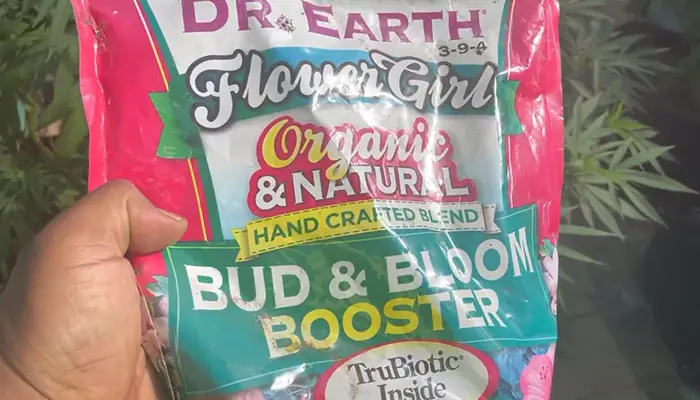
Over the years, many plant food companies emerged with their highly effective formulas. But Dr. Earth Flower Girl Bud & Bloom Booster always secured its position among the top 3 bloom boosters for flowering plants. Let’s see how-
Nutrient Composition
The NPK ratio of this bloom booster is 3-9-4. That means 3% of the packet weight is N while P & K is 9% & 4% respectively.
You know, the company only declared the presence of these macronutrients which Lilacs need in higher amounts.
But I have found out that 100% organic sources like fish bone meal, bone meal, alfalfa meal, potassium sulfate, feather meal, kelp meal & kelp flour also provide micronutrients like iodine, calcium, iron, magnesium, phosphorus, potassium, sodium, chromium, manganese & zinc.
Nutrient Analysis
I don’t think you could find a more perfect organic fertilizer for your Lilacs. This bloom booster is OMRI, OIM, CCOF & NOP approved for organic gardening. Moreover, all 3% of the N is water-insoluble & which ensures a slow release of N for long-term feeding.
Furthermore, the high P content is very efficient to snatch out buds & flowers of your lilacs for bumper blooming.
Exclusive Highlights
The flower girl is blended with pure love for your garden plants like Lilacs, roses, bougainvilleas, citrus, fruiting trees & all flowering vines. Additionally, the company declared this product safe for pets & people & ensured no use of GMO-infested chicken manures to keep it organically pure.
Anyway, the most attractive part of this organic & natural handcrafted blend is, it contains TruBiotic. TruBiotic is a composition of beneficial soil microbes plus mycorrhizae. These colony-forming units break down organic nutrients thoroughly to keep the soil fertile and increase plant performance.
Moreover, the bud & bloom booster also has 6% Humic acid to help Lilac’s roots to receive water & nutrients exactly.
Applying Method
For 12″ potted Lilacs, sprinkle 4 tablespoons of the fertilizer evenly onto the soil. After that, scratch the soil with a hand rake & cover it with organic mulch. And the final task is watering thoroughly.
3. Espoma Plant-tone Plant Food
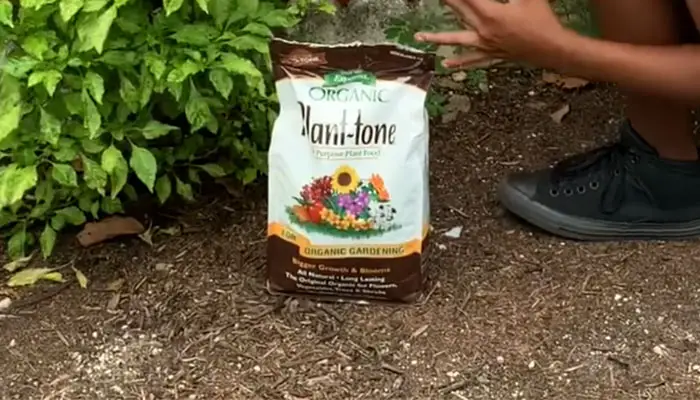
Choosing an all-purpose fertilizer is a bit tricky. Why? Because one right pick will be effective for most of your garden plants. Thereby, I was walking through several roads to pick up the ideal all-purpose fertilizer for your Lilacs & undoubtedly, Espoma Plant-tone tops the list.
Nutrient Composition
Espoma brand relied on natural & organic sources like feather meal, bone meal, poultry manure, alfalfa meal, green sand, sulfate of potash & sulfate of potash magnesia to gather up the nutrients.
The NPK ratio is 5-3-3. And additionally, this fertilizer also provides other macronutrients, such as Ca (5%), Mg (1%) & S (1%).
You might be happy to know that the sources also supply micronutrients required in smaller quantities like iron, manganese, copper, zinc, molybdenum, boron & chlorine to meet your Lilacs needs.
Nutrient Analysis
3% water-insoluble N is enough to take care of your Lilacs for a longer period but, it also supplies 2% N to feed instantly.
You know, soil preparation is important for Lilacs as they don’t require much fertilization before blooming. That’s when an equal amount of P & K ensures a calculated supply for your Lilacs.
However, other macro & micronutrients also help your Lilacs to get established & run the life cycle accurately.
Exclusive Highlights
Apart from Lilacs, this fertilizer is applicable to all your garden trees, shrubs, vegetables & flowers.
But the main show is The Espoma brand used their very own blend of beneficial colony-forming bacteria & mycorrhizae called BioTone. This formula makes your soil rich in available nutrients & keeps the soil well-drained.
Furthermore, 1% Humic acid is present in this fertilizer. It enhances nutrient uptake, drought toleration & root growth of your Lilac.
Applying Method
For potted Lilacs, mix 4 teaspoons of the fertilizer with the topsoils of a 12-inch diameter pot. After that, water thoroughly.
4. Nelson Plant Food For All Flowering Vines
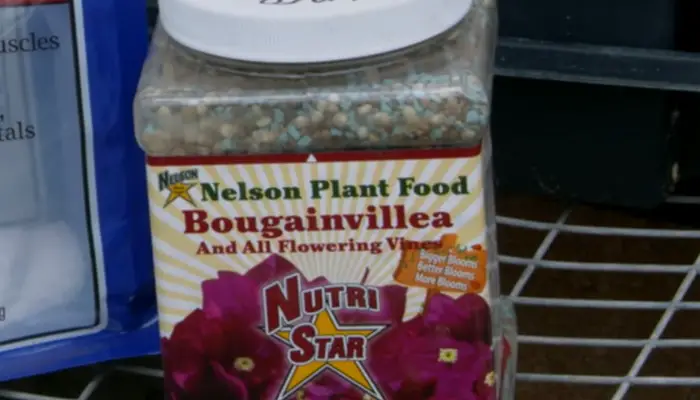
Nelson Plant Food company is best known for its custom blend high-quality fertilizers targeting particular plants. Since 1982, both commercial & residential growers have received its products with a smile on their faces. Similarly, all flowering vine food is no different from its other products.
Nutrient Composition
Nelson company used around 15 safe & eco-friendly inorganic products to blend this unique plant food. And the fertilizer supplies a wide range of essential macro & micronutrients, such as 17% N, 7% P, 10% K, 0.80% Mg, 9% S, 0.05% Cu, 2% Fe, 0.15% Mn & 0.20% Zn.
Nutrient Analysis
Nelson all flowering plant food supplies Nine essential nutrients for bigger, better & more Lilac blooms. You would notice that the plant food used four sources to gather N. Why?
Because the plant can uptake N in two different forms, nitrate (NO3) and ammonium (NH4). These sources supply both forms of N for optimum feeding. Moreover, 9.5% of N is slowly available for continuous feeding for up to one month.
Exclusive Highlights
Together with Lilacs, this plant food fits all flowering vines like Allamanda, Bougainvilleas, Coral Vines, Dipladenia, Honeysuckles, Jessamines, Mandevilla, Passion Vines, Queen Ann’s Lace, Trumpet Vines, Wisteria, etc.
However, I believe the product itself is an exclusive feature. As it is a Nutristar product, the release of targeted macro & micronutrients for Lilacs is guaranteed. So, you can keep your trust in Nelson Plant food because its well-researched products will never let you down.
Applying Procedure
Sprinkle the fertilizer all over the soil surface evenly 14 days before flowering. After that, the application every month is fine. The application dose is 2 tablespoons for a 14″ pot or container.
5. Osmocote Smart- Release Plant Food Flower & Vegetables
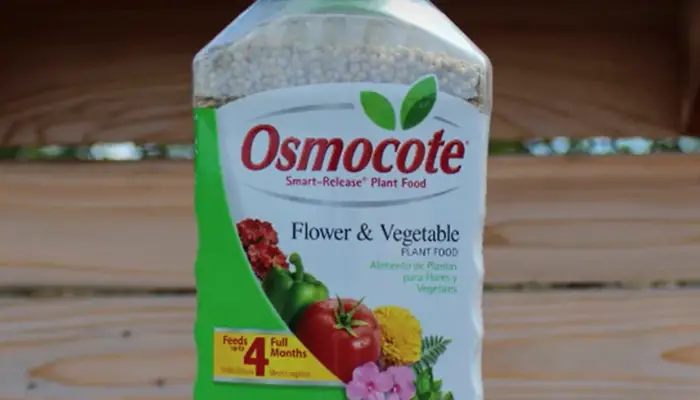
A morning shine of Lilacs may beautify your busy office work but, don’t let your busyness make the shining fade away. Keeping this in mind, I have come with a fertilizer that can feed your Lilacs & other vegetables & flowering plants for up to 4 months. Check it out-
Nutrient Composition
14-14-14. Yes, it is a balanced fertilizer as N, P & K have an equal share of the fertilizer. And all three nutrients are derived from four inorganic sources, such as polymer-coated ammonium nitrate, potassium sulfate, ammonium phosphate & calcium phosphate.
Nutrient Analysis
You know, a plant nutrient would be productively used by Lilacs only if the other necessary nutrients are present in sufficient quantities. And thus, balanced fertilizers ensure efficient nutrient use and soil productivity.
Moreover, the fertilizer supplies both forms of N for optimum uptake & proper growth.
Exclusive Highlights
You might be thinking about what this “Smart-Release” actually means, right? Well, these fertilizer granules are coated with a unique resin cover. After application, the granules get swollen up due to soil moisture & turns out to be liquid plant food capsules within a week.
Furthermore, the granules contain 12% N, 12% P & 12% K of slow-releasing type to keep you relaxed for the next four months.
Applying Method
For in-ground lilacs, sprinkle 3 tablespoons of the fertilizer evenly over the soil covered by a 2 ft diameter drip line. Mix the fertilizer with the topsoil & water thoroughly.
6. Scotts Evergreen Flowering Tree & Shrub Continuous Release Plant food

Another continuous release fertilizer shows up. So far, gardeners have found its potential for Lilacs, evergreens, dogwoods, hydrangeas, magnolias, and many acid-loving trees and shrubs like azaleas, rhododendrons & camellias. Let’s see what inside-
Nutrient Composition
The plant food contains 11% N, 7% P, 7% K & 2.1% S obtained from four inorganic sources- urea, polymer-coated, sulfur-coated urea, potassium chloride & ammonium phosphate.
Nutrient Analysis
You know, lilacs bloom only 2 or 3 weeks during the blooming period. And this fertilizer feeds your Lilacs for up to 2 months. So, your Lilacs won’t face deficiencies while blooming.
The plant food contains 5.2% slow-release N. It feeds your Lilacs continuously & secures green leaves, bud initiation, root development & other growth functions.
Exclusive Highlights
The fertilizer contains 2.1% elemental sulfur. Elemental sulfurs need to get oxidized to sulfate for plant uptaking & it occurs slowly to ensure a long-term supply.
Moreover, free sulfur makes an acidic soil alkaline to favor your Lilacs to bloom & grow.
Applying Method
For in-ground Lilacs, sprinkle the fertilizer evenly onto the drip zone & slightly beyond. The exact dose is half a tablespoon per 1 square foot area. After that, rake the soil a little & water.
7. Jobe’s Hanging Baskets & Potted Plants Fertilizer Spikes

This fertilizer is one of the best spike fertilizers for Lilac varieties like Betsy Ross, Miss Kim, Chinese Lilac, Persian Lilac, Common Lilac, Lavender Lady, President Grevy, Primrose, Sensation, Tinkerbelle, etc. Why?
Let’s see-
Nutrient Composition
The fertilizer offers a firm nutrient composition for pots or hanging baskets. It contains 8% N, 9% P & 12% K from synthetic sources like ammonium sulfate, ammonium phosphate, potassium nitrate, potassium sulfate & chlorine.
Nutrient Analysis
Interestingly, the fertilizer carries 6% N, 6.6% P & 8.4% K which are in occluded form. You know, occluded nutrients are slow releasers and that’s why they can feed your Lilacs for up to 2 months.
Exclusive Highlights
The best part of these spikes is, each spike contains Jobe’s Biozome. It is a unique mixture of healthy bacteria, Mycorrhizal fungi, and Archaea.
This blend enables the spikes to improve soil quality, growth and to protect against disease, insects & drought. Moreover, spike formulation ensures no waste or runoff & pre-measured formula supplies proper nutrients at the right time & the right amount.
Applying Method
For potted Lilacs, take 2 spikes for a 12″ pot. Push the spikes near the edges of the pot & then water thoroughly.
What To Feed Lilacs?

What you should feed your Lilacs? The answer depends on diverse determinants. Namely-
- Feeding time, for example- before blooming, or during the growing season.
- Soil nutrient status, such as which nutrients are inadequate in amount or excessively present
- Soil pH, etc
But on the whole, secure that your fertilizer provides both macro & micronutrients as much as possible. A balanced fertilizer is fairly enough for soil preparation before planting Lilacs. But in general, medium Nitrogen, Potassium & high Phosphorus-containing fertilizers are recommended to promote bumper flowering.
Significantly, Lilacs like neutral to slightly alkaline soil. So, make sure that your fertilizer takes care of that. Or you can also use bone meal or limestone to sweeten the soil.
And additionally, the proper amount of fireplace ash, grass clippings, coffee ground, Epsom salt, banana peel, etc may help you get bigger & plentiful lilacs. But wait, don’t get overboard with these. Otherwise, the soil may end up being toxic.
When To Fertilize Lilac?
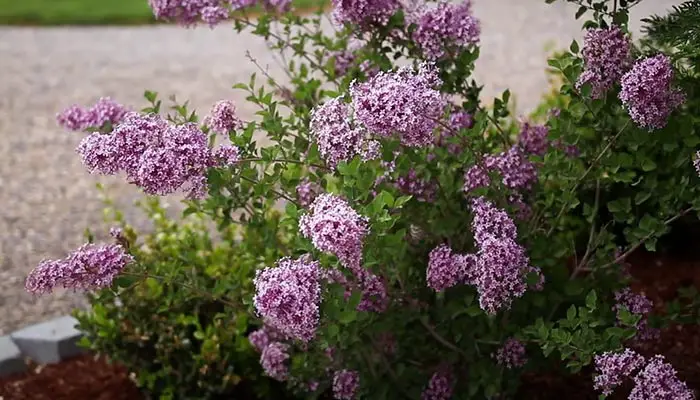
After planting, Lilacs may take up to 3 years for their very first flowering. And the good news is, experts & scientists have suggested no fertilization during this period. That’s why good soil preparation is necessary.
However, established Lilacs require fertilization when the growing season starts & that is early spring. From February to March, you will notice new leaves in your Lilac bushes & that’s the time to fertilize. But remember not to over-fertilize your Lilacs. Otherwise, they may stop flowering.
How To Fertilize Lilacs?
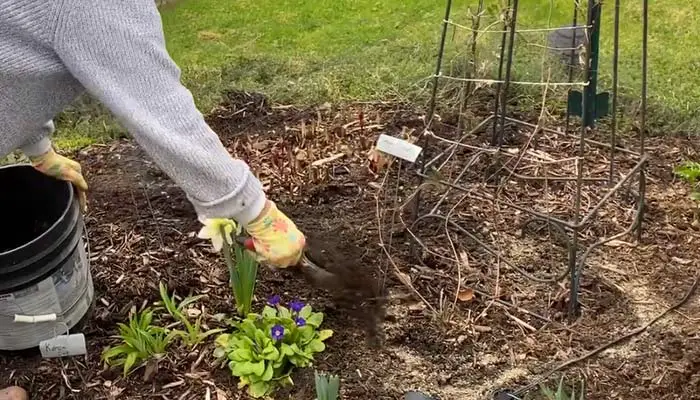
It is the phase when you look for the directions in the fertilizer packet. Well, that’s what you should do. Always read the directions properly & maintain them strictly. But for easy understanding, here are the steps-
Granular Formation
- Measure exact amount of fertilizer following the product label
- Sprinkle all over the soil of the drip zone or of the pot.
- Rake the topsoil slightly
- Water thoroughly.
Liquid Formation
- Mix the exact dose of fertilizer with water maintaining the direction of the product.
- Drench the soil or spray according to the label.
Spike Formation
- Read out the directions carefully & take the exact number of spikes for your Lilacs.
- Push the spikes against the soil & place them nearly 2/3 inches deep. For in-ground Lilacs, place the spikes following the dripline & for pots, place them near the edges.
- Water thoroughly.
How To Make Lilacs Bloom?

Here are some tips to make your Lilacs bloom-
- Choose a bloom booster or Phosphorus rich fertilizer for your Lilacs.
- Ensure direct sunlight for 5-6 hours regularly.
- For potted Lilacs, you may have to repot after a certain period in case of pot-bound roots. Otherwise, Lilacs may stop flowering.
- Avoid too much Nitrogen supply. Excessive nitrogen stimulates more leaf & branch growth instead of flowering.
- Lilacs bloom on old wood. So, prune them just after the flowering period, mostly in midsummer.
How To Choose The Best Fertilizer For Lilacs- Buyer’s Guide
Before choosing the perfect fertilizer for your Lilacs, you must know, what kind of fertilizer is best for Lilacs–
In short, any organic or synthetic fertilizer that has both slow & instant nutrient release capacity, offers nearly the same, equal, or higher phosphorus content than N & K & takes care of the soil quality.
Anyway, it is not easy to find one that meets all the requirements but if you follow my steps, it will probably be a little bit easier.
Step 1: Organic, Synthetic, or Semi-organic
There is no hard & fast rule or logic to select one from these categories because Lilacs only take the nutrients, do not care about the sources.
So, it is totally up to whether to use an organic, synthetic, or semi-organic one. But always choose one that supplies the maximum number of required nutrients for your Lilacs.
Step 2: Granular, Liquid, or Spike
There are several ways to get one from these three. But I suggest granular fertilizer for in-ground Lilacs, especially trees. And liquid & spike fertilizers for containers, pots, or hanging baskets. Because this way it is easier & comfortable to apply fertilizers.
Step 3: How Long Will It Feed Your Lilacs?
Lilacs don’t need fertilizers during the first 2 or 3 years before flowering. That’s why fertilizer that can feed for a long time is best for soil preparation.
And also, after blooming or established plants, Lilacs need fertilization once or twice a year. Moreover, a long feeder will reduce your fertilization work too. So, if other requirements are present in the fertilizers, grab one that feeds for a longer period.
Step 4: Exclusive Features
By exclusive features, I meant any feature that nourishes the soil quality & keeps it fertile. It is sort of a bonus point. That means, it is good to get a bonus but without it, your Lilacs will do fine.
Homemade Fertilizers For Lilacs
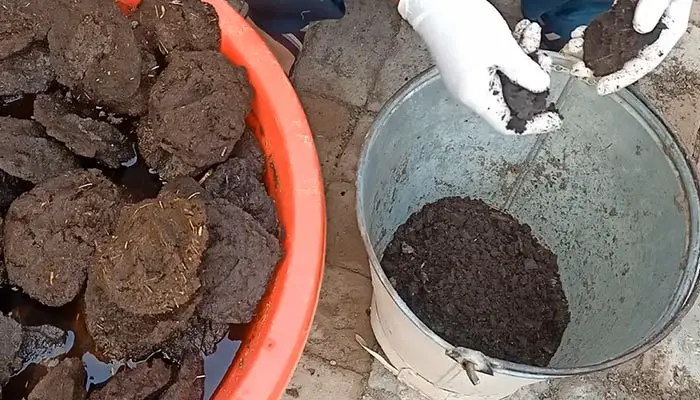
Items Required:
- Cow dung
- Banana Peels
- Bone meal
- Eggshells
- Epsom Salt
- Watering Can
Steps:
- Dry cow dung, eggshells, pieces of banana peels separately & further, grind them separately too.
- Mix these 3 grinded components into a 1:1:1 ratio.
- Now sprinkle the mixture evenly onto the soil of the drip zone.
- After that, take the watering can, fill it with water & mix 1 teaspoon Epsom salt & bone meal with it.
- And finally, drench the soil with the liquid mixture.
Note: Cow dung, Epsom salt, eggshells, banana peels, bone meal adds nitrogen, phosphorus, potassium, magnesium, iron, calcium, sulfur & zinc to the soil respectively. Besides, the bone meal helps to alkaline the soil for Lilacs.
Frequently Asked Questions
Is Miracle Grow Good For Lilacs?
Miracle-Gro Shake ‘N Feed Plant Food is a recommended slow-release fertilizer for Lilacs. It comes up with an ideal nutrient composition to feed your Lilacs for up to 3 months & guarantees deep green leaves with bright blooms.
Are Coffee Grounds Good For Lilacs?
Coffee grounds offer several essential nutrients to your Lilacs, such as N, P, K, Ca, Mg, Cu, B, Zn, Fe, etc & keeps away multiple insects from the plant. But a high amount of Coffee ground may add too much nitrogen to the soil & acidify it. That’s why it is good if you use coffee grounds sparingly.
Is Epsom Salt Good For Lilacs?
Epsom salt can boost up the blooming & greening process of your Lilacs effectively. It adds Mg & S to the soil which are indirectly involved in the flowering process. Mix 1 tablespoon per gallon of water & apply once a month.
Are Eggshells Good For Lilacs?
The eggshell contains 40% Calcium which is vital for lilacs for strong structural support. It promotes a strong cell wall, thereby Lilacs get a hard bone to keep upstanding.
Is Cow Manure Good For Lilacs?
The NPK ratio of cow manure is 3-2-1. That means it adds a considerable amount of essential nutrients to the soil. SO, Lilacs will love it until it causes excessive N supply & toxicity. That’s why Maintain a proper dose.
Do Lilac Bushes Like Chicken Manure?
Chicken manure contains nearly 13 essential plant nutrients for Lilacs. These include N, P, K, Ca, Mg, S, Mn, Cu, Zn, Cl, B, Fe & Mo. Along with nutrients, chicken manure enriches the organic matter of the soil & makes it fertile. But don’t apply raw manure to the soil as it causes root burning of Lilac bushes.
Is Blood Meal Good For Lilacs?
A blood meal is enriched with N as normally the NPK ratio is 13-0-0. So either you use it in a very small amount for Lilacs or don’t use it at all if there is not too much deficiency of Nitrogen.
Is Holly Tone Good For Lilacs?
Espoma Holly-Tone organic fertilizer is a good choice for Lilacs. It supplies 2.5% slow-release N for long-term feeding while it nourishes the soil too. Combinedly, Holly-Tone ensures more Lilac blooms with vibrant colors.
Are Lilacs Acid-Loving Plants?
It depends on varieties. Most Lilac varieties are fond of neutral to slightly alkaline soil. But some are found to be okay with a soil pH range of 6.5 to 7.
Conclusion
The spring celebration starts with the blooming of Lilacs. From ancient Greek to today’s enchanting Lilac festivals, undoubtedly, Lilacs kept us smiling with their pleasant beauty.
So far, my efforts were to keep these charming flowers blooming elegantly. I have researched a lot to snatch out the perfect fertilizer for them & finally listed the 7 best fertilizers for Lilacs.
I hope my work makes your research a bit shorter & easier. Now pick the right one & enjoy the colors.
